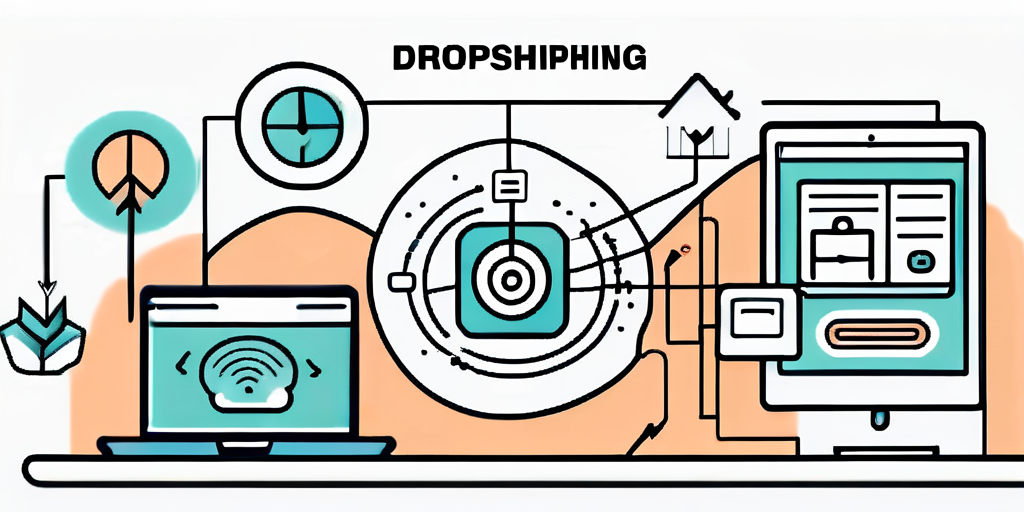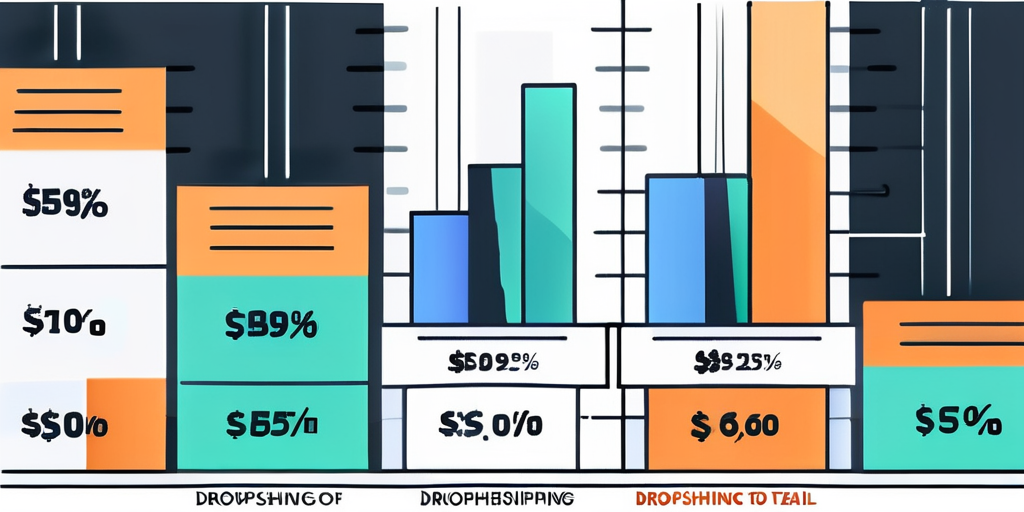In recent years, dropshipping has gained immense popularity as a business model. Entrepreneurs are drawn to the idea of starting an online store without the hassle of inventory management and fulfillment. But, does dropshipping really work? In this comprehensive analysis, we will delve into the concept of dropshipping, explore its pros and cons, discuss key factors influencing success, analyze financial aspects, and examine the role of e-commerce platforms in this business model.
Understanding the Concept of Dropshipping
Dropshipping is a business model where the retailer does not keep physical inventory in stock. Instead, when a product is sold, the retailer purchases it from a third-party supplier who then ships it directly to the customer. This eliminates the need for warehousing and inventory management.

Definition of Dropshipping
Dropshipping can be defined as a retail fulfillment method where the retailer does not stock products but instead transfers the customer’s orders and shipment details to the supplier, who then ships the products directly to the customer.
The Process of Dropshipping
The process of dropshipping involves several steps. First, the retailer sets up an online store and lists products from suppliers. When a customer places an order, the retailer forwards the order and customer details to the supplier. The supplier then handles the packaging and shipping of the product directly to the customer.
One of the key advantages of dropshipping is the flexibility it offers to retailers. Without the need to invest in inventory upfront, retailers can easily test different products and markets without the risk of being stuck with unsold stock. This allows for greater experimentation and adaptability in the ever-changing world of e-commerce.
Moreover, dropshipping provides retailers with the opportunity to offer a wide range of products to their customers. Since they are not limited by physical storage space, retailers can partner with multiple suppliers and offer an extensive product catalog. This variety can attract more customers and increase sales potential.
Another benefit of dropshipping is the ability to scale the business quickly. As the retailer does not have to worry about inventory management and order fulfillment, they can focus on marketing and customer acquisition. This means that as the business grows, the retailer can easily handle a higher volume of orders without the need for additional resources or infrastructure.
The Pros and Cons of Dropshipping
Before embarking on a dropshipping venture, it is important to consider the advantages and disadvantages of this business model.
Advantages of Dropshipping
One of the major advantages of dropshipping is the low startup cost. Since there is no need to invest in inventory, warehousing, or fulfillment infrastructure, entrepreneurs can start a business with minimal financial risk. This means that even individuals with limited capital can enter the e-commerce industry and pursue their entrepreneurial dreams.
Additionally, dropshipping offers flexibility as it can be run from anywhere with an internet connection, allowing entrepreneurs to work remotely and manage their business on-the-go. This freedom and mobility give individuals the opportunity to create a lifestyle that suits their preferences and priorities.
Another advantage of dropshipping is the wide selection of products available to sell. As a retailer, you can choose from thousands of products offered by different suppliers, enabling you to cater to various customer preferences and target specific niche markets. This vast array of options empowers entrepreneurs to curate a unique product offering that resonates with their target audience.
Furthermore, dropshipping eliminates the need for manual fulfillment tasks, such as packaging and shipping, allowing retailers to focus on marketing and customer acquisition. This streamlined approach enables entrepreneurs to scale their business more efficiently and dedicate their time to strategic growth. By leveraging automation tools and outsourcing certain aspects of the business, dropshippers can optimize their operations and maximize their productivity.
Disadvantages of Dropshipping
While dropshipping offers numerous advantages, it is essential to consider the potential disadvantages as well. One notable drawback is the lower profit margins compared to traditional retail models. Since the retailer does not have control over the product’s pricing, they receive a wholesale price from the supplier, leaving a narrower margin for profit. However, with effective marketing strategies and a focus on building customer loyalty, dropshippers can still generate substantial revenue despite the lower margins.
Another challenge is inventory management. As a dropship retailer, you rely on your supplier’s stock availability and must ensure accurate product listings to avoid selling items that are out of stock. Failure to manage inventory effectively can result in unhappy customers and damage your reputation. However, by establishing strong relationships with reliable suppliers and implementing inventory management software, dropshippers can mitigate this risk and ensure a seamless customer experience.
Furthermore, dropshipping may involve longer shipping times compared to traditional retail models. Since the products are shipped directly from the supplier to the customer, there may be delays in delivery, especially if the supplier is located overseas. However, by setting clear expectations with customers and providing transparent communication regarding shipping times, dropshippers can manage customer expectations and minimize potential dissatisfaction.
Key Factors Influencing Dropshipping Success
While dropshipping can be a lucrative business, success hinges on various factors that need careful consideration.
When it comes to choosing the right products to sell, it’s not just about randomly picking items from a catalog. Researching market trends and identifying profitable niches is crucial. You want to offer products that have a sufficient demand, ensuring that your efforts are not in vain. Understanding your target audience and their preferences is also pivotal in selecting products that align with their needs and aspirations. By doing so, you can create a curated collection that resonates with your customers, increasing the likelihood of repeat purchases and positive reviews.
Another key factor in dropshipping success is selecting reliable suppliers. You want to partner with suppliers who not only offer quality products but also provide reliable shipping and excellent customer service. After all, your reputation as a dropshipper is on the line. Establishing a strong relationship with your suppliers is essential to ensure seamless communication and timely order fulfillment. Regularly communicate with them, address any concerns, and work together to resolve any issues that may arise. By fostering a strong partnership, you can build trust and reliability, which are crucial for long-term success.
However, even with the right products and reliable suppliers, your dropshipping business won’t thrive without effective marketing strategies. Marketing plays a vital role in driving traffic to your online store, increasing brand visibility, and ultimately boosting sales. Utilize various marketing channels such as social media, search engine optimization (SEO), and influencer collaborations to reach your target audience. Engage with your potential customers through captivating content, compelling visuals, and enticing offers. By creating a strong online presence and building a community around your brand, you can establish trust and loyalty, converting visitors into loyal customers.
Remember, dropshipping success is not achieved overnight. It requires continuous effort, adaptability, and a customer-centric approach. By carefully considering these key factors and implementing effective strategies, you can set yourself up for long-term success in the competitive world of dropshipping.
Financial Aspects of Dropshipping
Understanding the financial aspects of dropshipping is crucial for making informed business decisions. In this section, we will delve deeper into the financial considerations that come with this business model.

Initial Investment and Potential Returns
One of the key advantages of dropshipping is its low upfront investment. Compared to traditional retail, where substantial capital is required for inventory, warehousing, and fulfillment, dropshipping allows entrepreneurs to start with minimal investment. This means that you can allocate your resources towards other areas of your business, such as marketing and customer acquisition.
However, it is important to note that the potential returns are dependent on various factors. Effective marketing strategies, a well-curated product selection, and operational efficiency all play a role in determining the success of your dropshipping venture. It is essential to conduct thorough market research and identify profitable niches to maximize your chances of success.
Understanding the Cost Structure
Dropshipping involves various costs that need to be considered. Besides the wholesale cost of the products, there are other expenses that you need to account for in your financial planning.
Firstly, website development and maintenance are crucial aspects of running an online dropshipping business. Investing in a user-friendly and visually appealing website can greatly enhance the customer experience and increase conversion rates. Additionally, regular website maintenance is necessary to ensure that your online store is running smoothly and efficiently.
Marketing expenses are another important consideration. While dropshipping eliminates the need for traditional advertising methods like billboards or print media, you will still need to invest in digital marketing strategies to drive traffic to your website. This may include search engine optimization (SEO), social media advertising, and influencer partnerships.
Transaction fees are also a part of the cost structure in dropshipping. Payment gateways and platforms that facilitate online transactions often charge a small percentage or a fixed fee for each transaction. It is important to factor in these fees when calculating your profit margins.
Lastly, customer service is a crucial aspect of any business, including dropshipping. Providing excellent customer support can help build trust and loyalty among your customers. However, it is important to allocate resources towards customer service, whether it is through hiring a dedicated team or investing in customer service software.
By analyzing and monitoring these costs, you can ensure profitability and sustainable growth in your dropshipping business. It is important to regularly review your financial performance and make adjustments as needed to optimize your operations.
The Role of E-commerce Platforms in Dropshipping
E-commerce platforms play a significant role in facilitating dropshipping businesses.

How E-commerce Platforms Facilitate Dropshipping
E-commerce platforms provide entrepreneurs with a user-friendly interface to set up and manage their online stores. These platforms often offer integrations with suppliers and shipping providers, streamlining the order fulfillment process. Additionally, they provide tools for inventory management, sales analytics, and marketing automation, enabling entrepreneurs to efficiently run their dropshipping business.
Choosing the Right E-commerce Platform
When selecting an e-commerce platform for your dropshipping business, consider factors such as ease of use, flexibility, available integrations, and pricing. Evaluate different platforms and choose the one that aligns with your business needs and growth goals.
In conclusion, dropshipping can be a viable business model for aspiring entrepreneurs. However, success in dropshipping requires a thorough understanding of the concept, careful consideration of the pros and cons, strategic decision-making regarding product selection, supplier partnerships, and marketing strategies. By comprehensively analyzing the financial aspects and leveraging the features offered by e-commerce platforms, entrepreneurs can embark on a successful dropshipping journey.

